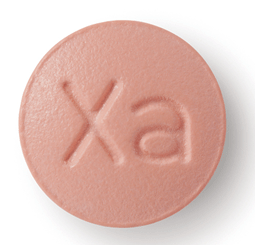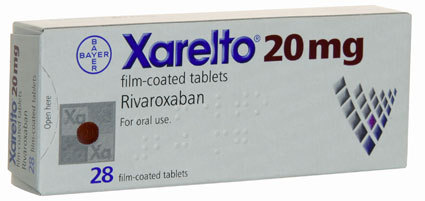 Rivaroxaban vascular dose, 2.5 mg twice daily, plus aspirin 100 mg once daily also significantly (p=0.0003) reduces the risk of the composite outcome of major cardiovascular events, major adverse limb events and major amputation in patients with peripheral artery disease.
Rivaroxaban vascular dose, 2.5 mg twice daily, plus aspirin 100 mg once daily also significantly (p=0.0003) reduces the risk of the composite outcome of major cardiovascular events, major adverse limb events and major amputation in patients with peripheral artery disease.
In a separate analysis of patients with coronary artery disease, treatment with rivaroxaban plus aspirin resulted in a significant net benefit and a 23% reduction in deaths, highlighting the potential of this regimen to substantially reduce morbidity and mortality from coronary artery disease.
Bayer and its cooperation partner Janssen Research & Development has announced two publications of further data from the Phase III COMPASS study in The Lancet, one in patients with peripheral artery disease (PAD) and the other in patients with coronary artery disease (CAD). Findings from the PAD analysis showed that rivaroxaban (Xarelto, Bayer) vascular dose, 2.5 mg twice daily, plus aspirin 100 mg once daily substantially reduced the risk of major amputation by 70% (relative risk reduction) (absolute risk reduction; ARR 1.5%) and the risk of the composite outcome of major adverse cardiovascular events (MACE), major adverse limb events (MALE) and major amputation by 31% (relative risk reduction; ARR 1.2%), compared with aspirin 100 mg once daily alone.
Additional data for this treatment regimen in patients with PAD demonstrated a 28% relative risk reduction (ARR 1.4%) in the primary efficacy outcome of MACE, and a 46% relative risk reduction (ARR 1.8%) in MALE, compared with aspirin 100mg once daily alone. Bleeding rates were low, and while major bleeding was increased, there was no significant differences in fatal bleeding, non-fatal intracranial bleeding or bleeding into a critical organ between any of the treatment groups.
Similarly, within the population of patients with CAD, the combination of rivaroxaban vascular dose plus aspirin also reduced the risk of the primary endpoint of MACE compared to aspirin alone.
All-cause mortality was also evaluated separately in both patient populations, with rivaroxaban 2.5 mg twice daily plus aspirin 100 mg once daily reducing the risk of all-cause mortality compared to aspirin 100 mg once daily alone (HR 0·77, 95% CI 0·65–0·90, p=0·0012) in patients with CAD. In the analysis of patients with PAD, there was no significant reduction in all-cause mortality (HR 0·91, 95% CI 0·72–1·16, p=0·45).
 Furthermore, rivaroxaban 2.5 mg plus aspirin 100 mg once daily demonstrated an improvement in net clinical benefit in both patient populations compared with aspirin alone (28% in patients with PAD, and 23% in patients with CAD). The net clinical benefit was defined as the combined outcome of MACE, MALE and major amputation, balanced with fatal bleeding or symptomatic bleeding into a critical organ.
Furthermore, rivaroxaban 2.5 mg plus aspirin 100 mg once daily demonstrated an improvement in net clinical benefit in both patient populations compared with aspirin alone (28% in patients with PAD, and 23% in patients with CAD). The net clinical benefit was defined as the combined outcome of MACE, MALE and major amputation, balanced with fatal bleeding or symptomatic bleeding into a critical organ.
Andrew Garnham, consultant vascular surgeon at the Royal Wolverhampton NHS Trust, comments: “The COMPASS data continues to provide exciting results that will inform the future of cardiology practice in the UK. A focus on PAD is well overdue and once licensed, we are optimistic that treatment would help save not only limbs but lives. Patients affected by PAD are at high risk of both heart attack and stroke, and the COMPASS data has huge implications for patients in the UK with PAD who face the very stark reality of limb amputations or cardiovascular complications.”
Luis Felipe Graterol, UK Medical Director, Bayer, says: “The COMPASS results provide UK clinicians with the first glimpse of how rivaroxaban could protect patients with PAD, once licensed in this indication. PAD represents a major public health burden in the UK and these findings, coupled with our ongoing clinical development programme, demonstrates our commitment to patients with complex cardiovascular needs. This research also adds to the impressive body of evidence to supports rivaroxaban’s use across the widest spectrum of cardiovascular indications of any NOAC.”
Cardiovascular disease, which includes CAD and PAD, was responsible for approximately 17.7 million deaths in 2015, representing 31% of all global deaths. CAD alone led to 8.8 million deaths worldwide in 2015, while PAD affects approximately one in five people aged over 60 in the UK, and is an important risk marker for cardiovascular disease. Current guideline recommended treatment for these patients includes antiplatelet therapy. Anticoagulation therapy in combination with single antiplatelet therapy is currently only recommended in patients with PAD who have a concomitant indication and who have undergone a recent revascularisation.
These results, from both the PAD and CAD patient populations studied in the COMPASS trial, are consistent with findings from the full COMPASS study population (including patients with coronary artery disease), which were published in August 2017 in The New England Journal of Medicine.
Rivaroxaban is the only non-vitamin K antagonist oral anticoagulant (NOAC) investigated in these high-risk patient populations.









